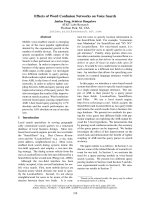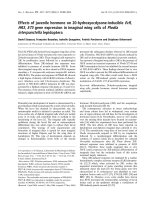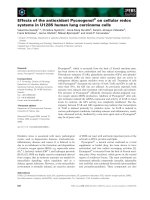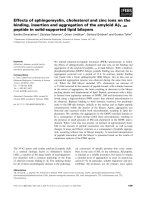Báo cáo khoa học: "Effects of decline and/or air pollution on the terpene metabolism of Picea abies needles" potx
Bạn đang xem bản rút gọn của tài liệu. Xem và tải ngay bản đầy đủ của tài liệu tại đây (203.51 KB, 4 trang )
Effects
of
decline
and/or
air
pollution
on
the
terpene
metabolism
of
Picea
abies
needles
A.
Saint-Guily
Laborafoire
de
Physiologie
Cellulaire
V6g6tale,
CNRS
UA568,
Unii
l
ersitd
de
Bordeaux
I,
33405
Talence
Cedex,
France
Introduction
The
terpene
metabolism
(mevalonic
acid
pathway)
is
a
secondary
metabolism
pres-
ent
in
all
plants.
Terpenes
are
elaborated
by
successive
condensation
of
isoprene
units
(C
5
).
C
10
and
C
15
terpene
molecules
are
the
main
constituents
of
the
volatile
oils.
These
volatile
terpenes
are
formed
in
secretory
systems.
Leucoplasts,
non-
green
plastids
(Carde,
1984),
are
involved
in
their
synthesis
(Gleizes
et al.,
1983).
In
conifer
needles,
these
plastids
are
local-
ized
in
the
epithelial
cells
of
the
subepider-
mal
resin
ducts.
In
Picea
abies
needles,
the
secretory
ducts
are
longitudinal
and
discontinuous.
Forest
decline
is
an
important
problem
which
appears
in
several
countries
in
Europe
and
North
America
(McLaughlin,
1985).
Most
of
the
damaged
forests
are
coniferous
forests
containing
mainly
spruce
(Picea).
Among
the
potential
causes
of
forest
decline,
air
pollution
has
received
particular
attention
(McLaughlin,
1985).
Previous
studies
have
shown
that
the
resin
content
of
pine
tissues
greatly
increases
after
mechanical
or
chemical
injuries:
wounding
(Vassiliev
and
Carde,
1976),
infestation
by
insects
and
infection
by
fungi
(Cheniclet,
1987)
or
treatment
with
herbicides
(Brown
and
Nix,
1975).
The
intention
of
this
study
was
to
eluci-
date
a
possible
relationship
between
the
stress
factors
and
a
variation
in
terpene
metabolism.
Materials
and
Methods
Different
samples
of
needles
were
collected
in
the
spruce
(P.
abies)
stands
which
were
located
in
the
Donon
forest
where
3
decline
classes
were
defined
with
respect
to
needle
loss:
class
2
(0-10%
needle
loss),
class
3a
(10-20%)
and
class
3b
(35-50%
with
yellowish
chlorosis).
Needles
of
3
consecutive
yr
from
about
12
trees
of
each
decline
class
were
collected.
The
other
samples
of
5
yr
old
clones
("lac
de
Constance"
(LC),
"G6rardmer"
(GER),
"Istebna"
(IST)
were
collected
in
the
open
top
chambers
of
Montar-
don
and
Donon.
These
plants
were
placed
under
controlled
conditions
of
air
pollution
which
were
equivalent
to
the
pollution
recorded
in
the
Donon
forest.
The
3
clones
were
placed
in
air-filtered
open
top
chambers
or
fumigated
with
ozone
(0
3)
or
sulfur
dioxide
(S0
2)
alone
or
a
mixture.
In
Montardon,
a
mobile
roof
protects
the
trees
from
the
rain.
Cytological
observations
were
made
with
an
electron
microscope.
RuBPCase
was
localized
on
ultrathin
sections
using
immunogold
labeling
techniques
(Shaw
and
Henwood,
1985).
The
leucoplastidial
volume
density
(LVD)
(%
of
the
cell
volume
occupied
by
leucoplasts)
was
esti-
mated
using
a
morphometric
technique
(Weibel,
1969).
For
analytical
studies,
oxygenated
and
hydro-
carbon
terpene
fractions
were
separated
on
a
silica
column
after
pentane
extraction
and
ana-
lyzed
with
a
gas
chromatograph,
using
an
apo-
lar
capillary
column
(Belingheri
et al.,
1988).
A
’desorption
concentration
injection’
system
(DCI,
Delsi,
France)
was
also
used.
About
5
needles
were
inserted
into
a
heating
block.
The
volatile
compounds
were
swept
by
a
carrier
gas
and
trapped
in
a
tenax
cartridge
attached
directly
to
the
injector
of
the
gas
chromatogra-
phic
apparatus
(the
injection
consists
of
a
ther-
mal
desorption
of
the
trapped
compounds).
The
statistical
evaluations
of
our
data
includ-
ed
an
analysis
of
variance
and
a
technique
for
testing
all
differences
between
pairs
of
means
(multiple
comparisons
among
pair
of
means:
V-
method)
(Spjotvoll
and
Stoline,
1973;
Sokal
and
Rohlf, 1981
).
Cytological
studies
Study
of
the
leucoplastidome
Leucoplastidome
and
decline
In
the
Donon
forest,
the
mean
volume
densities
of
leucoplasts
were
10%
for
the
’healthy’
trees
and
15,
18
and
19%
for
the
classes
2,
3a and
3b,
respectively.
Results
of
the
T!method
are
presented
in
Table
I.
The
pairs
of
damaged
classes
(2-3a,
2-3b
and
3a-3b)
did
not
show
any
signifi-
cant
differences
between
each
other.
But
a
significant
difference
did
exist
between
the
LVD
of
healthy
trees
and
the
LVD
of
all
the
other
classes.
Leucoplastidome
and
air
pollution
For
spruces
fumigated
with
air
pollutants
in
open
top
chambers,
the
estimation
of
For
each
pair
of
classes
the
sample
statistic
T’
was
calculated.
a
critical
value
of
the
studentized
augmented
range
table:
00
.05
!a.!2o)
=
3.68
5
the
LVD
was
different
between
the
trees
from
Montardon
and
these
from
Donon
experiments.
In
the
first
case,
the
LVD
was
about
20%
of
the
cell
volume
and
no
significant
difference
between
trees
fumigated
with
03,
S0
2,
03
+
S0
2
or
charcoal-filtered
air
could
be
shown.
Samples
from
Donon
showed
a
higher
LVD
for
fumigated
trees
(24%)
than
for
non-fumigated
ones
(13%).
Study
of
the
chloroplasts
(RuBPCase
labeling)
About
20
plastids
were
investigated
on
ultrathin
sections
for
each
decline
state.
Variance
analysis
of
these
results
verified
that
RuBPCase
labeling
was
not
equiva-
lent
for
the
different
classes.
The
average
densities
of
the
gold
labeling
(number
of
gold
particles
per
,um
2
of
chloroplast
section)
was
96
for
’healthy’
trees
and
126,
121
and
59
for
classes
2,
3a
and
3b,
respectively.
Only
the
3b
state
showed
significant
differences
with
the
3
other
classes
(Table
II).
Terpene
composition
Donon
forest:
declined
trees
No
significant
variation
of
terpene
compo-
sition
was
observed
in
correlation
with
the
decline.
Open
top
chambers
The
investigations
of
needle
samples
of
IST
from
the
Donon
forest
showed
a
constant
terpene
hydrocarbon
composi-
tion.
In
a
polluted
atmosphere,
the
propor-
tion
of
bornyl
acetate
increased,
while
the
proportion
of
camphor
decreased.
The
2
other
clones
(GER
and
LC)
presented
larger
proportions
of
pinene
and
cam-
phene
and
smaller
proportions
of
limon-
ene
in
needles
of
fumigated
trees.
In
the
Montardon
forest,
the
terpene
composition
of
IST
and
LC
was
indepen-
dent
of
air
pollution
conditions
during
the
growth
of
the
needles.
For
GER
the
concentrations
of
limonene
and
bornyl
acetate
seemed
to
be
different
between
fumigated
and
non-fumigated
trees.
However,
on
fully
grown
needles,
dif-
ferences
in
the
terpene
composition
were
no
longer
observed.
The
varying
terpene
patterns
found
in
these
needles
were
dependent
upon
the
origin
of
the
plants
and
not
upon
on
the
conditions
of
pol-
lution.
Discussion
There
are
significant
differences
between
the
leucoplastidial
volume
density
of
’heal-
thy’
and
damaged
trees
of
the
Donon
forest.
But
the
increase
of
the
LVD
and
the
decline
of
the
trees
did
not
seem
to
corre-
late
to
any
variation
of
terpene
composi-
tion
in
the
needles
of
P.
abies.
Therefore,
the
LVD
differences
could
be
due
to
a
shif-
ting
of
cell
differentiation
in
relation
to
the
different
localizations
of
the
healthy
and
damaged
tree
classes.
The
lower
labeling
density
of
RuBPCase
for
the
trees
with
bleached
needles
(state
3b)
would
be
due
to
an
irreversible
disturbance
of
the
me-
tabolism.
But another
experiment
with
a
larger
plastid
sampling
must
be
done
in
order
to
confirm
this
first
result.
In
the
open
t.op
chambers
of
the
Montar-
don
forest,
there
was
no
change
of
the
leucoplastidial
density
and
of
the
composi-
tion
of
the
terpene
hydrocarbons.
In
nee-
dle
samples
from
the
Donon
open
top
chambers,
the
decreased
LVD
was
cor-
related
to
changes
in
the
composition
of
the
oxygenated
compounds
for
IST.
The
terpene
composition
of
GER
and
LC
was
also
modified.
These
results
suggest
that
fumigation
and
natural
rain
are
necessary
to
produce
a
modification
of
the
terpene
metabolism
under
controlled
conditions.
References
Belingheri
L.,
Pauly
G.
&
Gleizes
M.
(1988)
Ter-
pene
hydrocarbons
from
Citrofortunella
mitis
fruits
and
leaves.
Plant
PhysioL
Life
Sci.
Adv.
7,
101-103
Brown
C.L.
&
Nix
L.E.
(1975)
Uptake
and
transport
of
paraquat
in
slash
pine.
For.
Sci.
21,
359-364
Carde
J.P.
{1984)
Leucoplasts:
a
distinct
kind
of
organelles
lacking
typical
70S
ribosomes
and
free
thylakoids.
Eur.
J.
Cetl Biol.
34, 18-26
Cheniclet
C.
(1987)
Effects
of
wounding
and
fungus
inoculation
on
terpene
producing
sys-
tems
of
maritime
pine.
J.
Exp.
Bot.
38,
1557-
1572
Gleizes
M.,
Pauly
G.,
Carde
J.P.,
Marpeau
A.
&
Bernard-Dagan
C.
(1983)
Monoterpene
hydro-
carbon
biosynthesis
by
isolated
leucoplasts
of
Citrofortunella
mitis.
Planta
159,
373-381
McLaughlin
S.B.
(1985)
Effects
of
air
pollution
on
forests.
A
critical
review.
Air
Pollut
Control
Assoc.
35,
512-534
Shaw
P.J.
&
Henwood
J.A.
{1985)
Immuno-gold
localization
of
cytochrome
f,
light-harvesting
complex,
ATP
synthase
and
ribulose
1,5-bis-
phosphate
carboxylase/oxygenase.
Planta
165,
333-339
Sokal
R.R.
&
Rohlf
F.J.
(1981)
In:
Biometry.
W.H.
Freeman
and
Co.,
New
York,
pp.
859
Spjotvoll
E.
&
Stoline
M.R.
{1973)
An
extension
of
T-method
of
multiple
comparison
to
include
the
cases
with
unequal
sample
sizes.
J.
Am.
Stat.
Assoc.
68,
975-978
Vassiliev
A.E.
&
Carde
J.P.
(1976)
Effects
du
gemmage
sur
l’ultrastructure
des
cellules
s6cr6-
trices
des
canaux
de
1’6corce
des
tiges
de
Pinus
sylvestris
L.
et
Picea
abies
(L.)
Karst.
Protoplasma
89,
41-48
Weibel
E.R.
(1969)
Stereological
principles
for
morphometry
in
electron
microscopic
cytology.
Int
Rev.
Cytol.
26,
235-302









